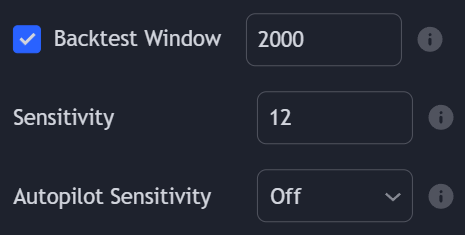
Long/Short Entry Conditions
Users can specify their strategy respective long/short entry rules from the LONG CONDITIONS and SHORT CONDITIONS settings sections, using the following available options:| Condition | Options | Options (2) | Description |
|---|---|---|---|
| Signal Type |
|
| Enter a position on the occurrence of the user specified signal. Users can select between the Confirmation and Contrarian signals algorithm (Long/Short conditions can use different algorithms), these are affected by the selected Sensitivity and Autopilot frequency settings. Selecting “Bullish Classifier” or “Bearish Classifier” will open positions on the occurence of a signal with the same classification as the one specified by the user on the rightmost input. |
| Reversal Zones | Cross Over R3, Cross Over R2, Cross Over R1, Cross Under S1, Cross Under S2, Cross Under S3, Above R3, Within [R3-R2], Within [R2-R1], Within [R1-S1], Within [S1-S2], Within [S2-S3], Under S3 | Enter a position if price is above/under or within the specified extremities. | |
| Smart Trail |
| Enter a position if the Smart Trail switch bullish/bearish or if it is currently bullish or bearish. | |
| Trend Tracer |
| Enter a position if the Trend Tracer switch bullish/bearish or if it is currently bullish or bearish. | |
| Trend Catcher |
| Enter a position if the Trend Catcher switch bullish/bearish or if it is currently bullish or bearish. | |
| Neo Cloud |
| Enter a position if the Neo Cloud switch bullish/bearish or if it is currently bullish or bearish. | |
| Trend Strength |
| Enter a position if the Trend Strength is greater or lower than the specified value. | |
| Session | Session interval | Enter a position if it is within the user specified session interval. | |
| External Condition 1 |
| Enter a position if the tested condition between the first specified external source and second one is true. | |
| External Condition 2 |
| Enter a position if the tested condition between the first specified external source and second one is true. | |
| External Condition 3 |
| Enter a position if the tested condition between the first specified external source and second one is true. Users can use price placeholers such as open, high, low, close, hl2, ohlc4, hlc3, and hlcc4 instead of a numerical value in the second source input. |
If the Exit On Signal setting is enabled, existing positions will be exited on the occurrence of a confirmation/contrarian signal if enabled.
No Existing Positions Requirement
Users can enable the Don’t Allow Trades Until Closed setting in order to only open trade when no existing positions are open. This setting allows waiting for a position to be closed before one can be opened.Enabling Don’t Allow Trades Until Closed for long positions will prevent opening shorts as long as a long position is opened.If this same setting is not enabled for short conditions then shorts can effectively be closed by new long positions.

